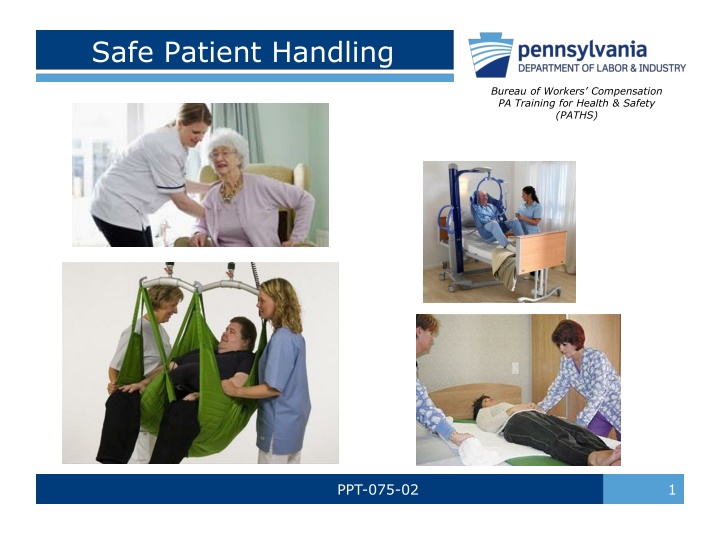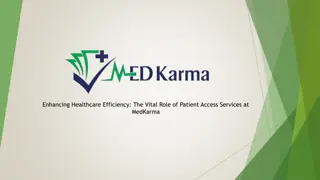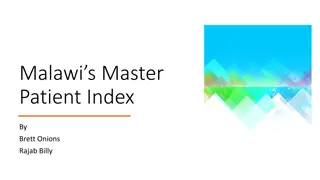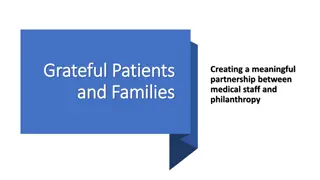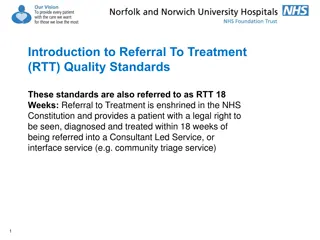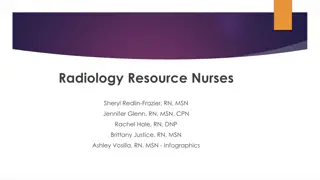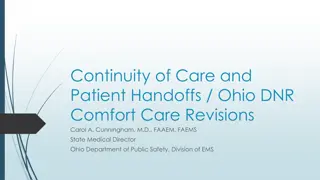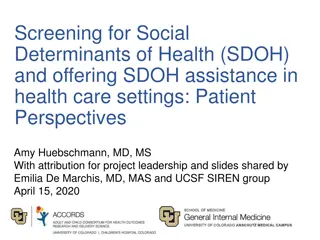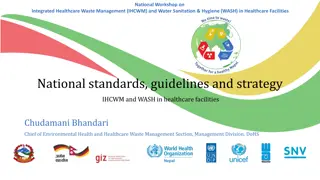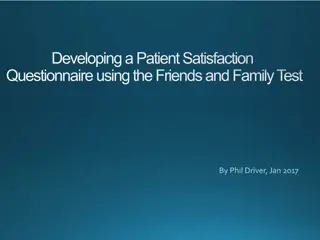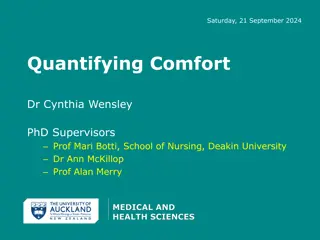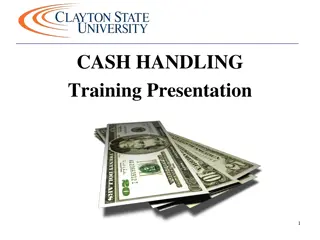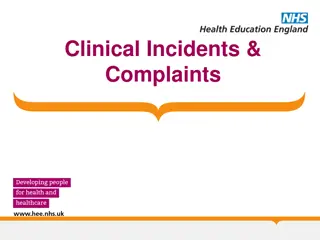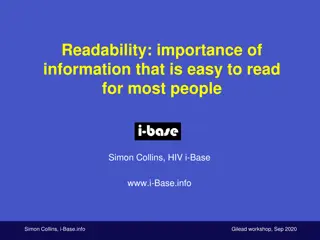Ensuring Safe Patient Handling in Healthcare Settings
This presentation discusses the risks of musculoskeletal injuries in healthcare due to manual patient handling, emphasizing the importance of proper techniques and patient lift equipment. It highlights rising challenges such as obesity rates, an aging workforce, and workforce shortages contributing to the increased physical demands on healthcare caregivers. The statistics reveal the prevalence of back pain among nurses and the limitations of relying solely on manual lifting techniques. Debunking myths about manual lifting versus using patient lift equipment, the presentation stresses the importance of prioritizing caregiver and patient safety in patient handling practices.
Download Presentation

Please find below an Image/Link to download the presentation.
The content on the website is provided AS IS for your information and personal use only. It may not be sold, licensed, or shared on other websites without obtaining consent from the author.If you encounter any issues during the download, it is possible that the publisher has removed the file from their server.
You are allowed to download the files provided on this website for personal or commercial use, subject to the condition that they are used lawfully. All files are the property of their respective owners.
The content on the website is provided AS IS for your information and personal use only. It may not be sold, licensed, or shared on other websites without obtaining consent from the author.
E N D
Presentation Transcript
Safe Patient Handling Bureau of Workers Compensation PA Training for Health & Safety (PATHS) PPT-075-02 1
What Well Talk About Injury Risk Myths vs. Facts Musculoskeletal Disorders Body Mechanics/Ergonomics Using a Patient Lift Proper Lifting Techniques PPT-075-02 2
Injury Risk Rates of musculoskeletal (MSD) injuries from overexertion in healthcare occupations are among the highest of all U.S. industries. Bureau of Labor Statistics (BLS) on average: rate of overexertion injury across all industries is 38 per 10,000 full time workers. Rate for hospital workers twice the average (76 per 10,000); Nursing home workers 3x the average (132 per 10,000); ambulance workers 6x the average (238 per 10,000) Single greatest risk factor: manual patient handling PPT-075-02 3
More Risks o Rising obesity rates in the U.S. have increased physical demands on caregivers o Aging workforce: average age of registered nurse in U.S. = 47 o Ongoing shortage of nurses/other caregivers o Healthcare organizations cutting workforce o Longer work schedules PPT-075-02 4
Some Statistics* 52% of Nurses experience chronic back pain 12% leave nursing because of back pain 20% transfer to a different unit due to back pain Back pain is the leading cause of disability to nurses under 45 years of age *American Nursing Association, Handle with Care http://www.nursingworld.org/MainMenuCategories/OccupationalandEnvironmental/occupationalhealth/handlewithcare/hwc.aspx PPT-075-02 5
Moving Patients-Myths vs. Facts Myth: We can train workers to use proper body mechanics and avoid injuries. Fact: More than 30 years of research and experience shows relying on proper body mechanics or manual lifting alone is not effective to reduce back/other MSD s. Myth: Patients are not as comfortable or safe with mechanical lifting. Fact: Patient education can reinforce that the lift is for the patient s safety as well as the caregivers. Patient handling equipment can prevent falls, bruises, and skin tears. PPT-075-02 6
Moving Patients-Myths vs. Facts Myth: It takes less time to manually move patients than to use lifting equipment. Fact: It can actually take much longer to get a team of co-workers together to manually lift a patient than to find and use lifting equipment. Attempting to lift a patient by only one person puts that caregiver at risk of injury. Using mechanical devices takes fewer personnel and about 5 minutes less. PPT-075-02 7
Musculoskeletal Disorders (MSDs) Injury or disorder of the: Muscles Nerves Tendons Joints Cartilage Spinal Discs PPT-075-02 8
Stages of MSDs Early stage pain may disappear after a rest away from work Intermediate stage body part aches and feels weak soon after starting work and lasts until well after finishing work Advanced stage body part aches and feels weak even at rest, sleep may be affected, light tasks are difficult on days off PPT-075-02 9
MSDs-Signs & Symptoms Do not ignore signs & symptoms! o Pain o Aching o Swelling o Burning o Stiffness o Cramping o Tingling o Loss of Color o Weakness o Numbness PPT-075-02 10
Before Patient Handling Wear the right clothes: Make sure your clothing and footwear are appropriate clothes should allow free movement and shoes should be non-slip, supportive and stable. Know your limits: Know your own capabilities and don t exceed them for instance, if you need training in the technique to be used, tell your Supervisor. Do one thing at a time: Don t try to do two things at once for instance, don t try to adjust the patient s clothing during the transfer. Prepare for the task: Make sure everything is ready before you start for instance, check other care givers are available if needed, equipment is ready and the handling environment is prepared. Apply safe principles: Always use safe body mechanics and use rhythm and timing to aid the task. PPT-075-02 11
Patient Handling vs. Other Lifting The load is often unstable Patients do not have handles A patient s weight is distributed unevenly A patient may be combative PPT-075-02 12
Patient Handling Methods Most common taught are body mechanics and the principles of ergonomics PPT-075-02 13
Important Principles-Body Mechanics Apply safe body mechanics and maintain the natural curve of your spine to minimize the force on your joints and discs. Here s the safe way to hold your body: Stand in a stable position: Your feet should be shoulder width apart with one leg slightly forward to help you balance you may need to move your feet to maintain a stable posture. Avoid twisting: Make sure your shoulders and pelvis stay in line with each other. Bend your knees: Bend your knees slightly, but maintain your natural spinal curve avoid stooping by bending slightly at the hips (buttocks out). Elbows in: Keep your elbows tucked in and avoid reaching the further away from the body the load is, the greater the potential for harm. Tighten abdominal muscles: Tighten your abdominal muscles to support your spine. Head up: Keep your head raised, with your chin tucked in during the movement. Move smoothly: Move smoothly throughout the technique and avoid fixed holds. PPT-075-02 14
Important Principles-Body Mechanics When handling/moving patients: 1) Maintain a wide, stable base with your feet 2) Put the bed at the correct height (waist level when providing care; hip level when moving a patient) 3) Try to keep the work directly in front of you to avoid rotating the spine 4) Keep the patient as close to your body as possible to minimize reaching CAUTION: Body mechanics alone is not sufficient! PPT-075-02 15
Ergonomics Ergonomics: The science of fitting jobs to people. Encompasses the body of knowledge about physical abilities and limitations as well as other human characteristics relevant to job design Ergonomic design: The application of this body of knowledge to the design of the workplace (tasks, equipment, environment) for safe and efficient worker use Good ergonomic design: Makes the most efficient use of worker capabilities while ensuring job demands do not exceed those capabilities 16 PPT-075-02
Ergonomic Risk Factors In patient care occupations: Forceful and Heavy Exertions o o High Frequency/Repetitive Tasks o Awkward Postures o Work Duration o Uneven work floors o Unpredictable patients o Dependence level of patients PPT-075-02 17
Ergonomic Risk Factors In patient care occupations: o Lifting heavy loads o Excessive pushing/pulling o Reaching PPT-075-02 18
Use Caution There are lifting tasks that are so stressful to the body even if proper body mechanics and ergonomics are used a person can still suffer an injury! PPT-075-02 19
Team Lifting o More than one person required to lift a load: team of folks; one person calls directions and lifting steps so everyone will move at the same pace. o Can be used when the patient is very large or overly obese. o Team members must still use caution to ensure proper body mechanics and ergonomic issues are addressed. PPT-075-02 20
Prepare for Safe Patient Handling Know what equipment is available and how it works Assess the patient and the environment Gather appropriate equipment and staff needed Coach Patient PPT-075-02 21
When & Why to Use Lifting Devices Patient Benefits: o Patient comfort o Respects a patient s sense of dignity o Promotes patient independence and rehabilitation PPT-075-02 22
Economic Benefits of Lifting Devices Decreases occupational injuries and indirect costs including: Employee replacement Additional training Loss of productivity Liability PPT-075-02 23
When to Use a Lift For most patient-lifting tasks maximum weight limit is 35 pounds.* Patient characteristics that add risk: o Height o Weight o Body Shape o Dependency *Waters, Thomas R. PhD. (2007). When Is It Safe to Manually Lift a Patient?. AJN, Vol. 107, No. 8. 53-59. PPT-075-02 24
When to Use a Lift PPT-075-02 25
Employee Responsibility Know the characteristics of an unsafe lift Know the help that is available both coworkers and equipment Know your employer s lift policies If unsure about the safety of a lift, ask your instructor/director PPT-075-02 26
Risk Factors What do you see? Patient may have difficulty supporting full weight Can nurse support full weight of patient by herself? If patient begins to fall what will the nurse do? Is the patient wearing non-slip footwear; floor slippery? PPT-075-02 27
Sitting a Patient Up in Bed If the person is not strong enough to push up with his or her hands to a sitting position, place one of your arms under the person's legs and your other arm under his or her back. Move the person's legs over the edge of the bed while pivoting his or her body so the person ends up sitting on the edge of the bed. Keep your feet shoulder-width apart, your knees bent and your back in a natural straight position. PPT-075-02 28
To Assist with Standing up o Position the person's feet on the floor and slightly apart. o The patient's hands should be on the bed or on your shoulders. o Place your arms around the person's back and clasp your hands together. o If the patient is wearing a lifting belt make sure it is fastened around their waist. o Grasp the belt when lifting the patient. o Hold the person close to you, lean back and shift your weight. PPT-075-02 29
To Assist with Sitting Down Into a chair, wheelchair, on a bed: Pivot toward the chair, bend your knees, and lower the person into the chair. The person should have both hands on the arms of the chair before lowering him/her down. PPT-075-02 30
Types of Transfers Bed Chair Commode/toilet Lateral transfers Floor Vehicle PPT-075-02 31
Repositioning Chair Bed Gurney Diagnostic tables PPT-075-02 32
Transfer & Repositioning Factors Patient Personnel Equipment Environment PPT-075-02 33
Patient Medical condition history Mental status cooperative, follows directions etc. Functional status- strength, balance, coordination & stamina PPT-075-02 34
Environment Design of the room Furniture Medical equipment Lighting Climate/temperature Traffic/activity Is there anything wrong with this? Posture of care giver could lead to an injury PPT-075-02 35
Personnel Education/Training Competency Compliancy Teamwork Communication PPT-075-02 36
Equipment Bed Ceiling lift Total mechanical lift Sit to stand lift Transfer belt Non-Friction device/Air assistive device Assistive devices (cane, wheelchair, etc.) PPT-075-02 37
Before the Task, Remember o Check patient profile: Decide if the task is still necessary and that the handling plan is still appropriate. o Seek advice: Talk to your manager or the patient handling adviser if you need advice on the techniques and equipment you should be using. o Check equipment: Ensure equipment is available in good condition with all components in place and ready to use. Always follow the manufacturer s instructions. o Prepare handling environment: Position furniture correctly, check route and access ways are clear, and check the destination is available. o Explain the task: Explain the task to the patient and other care givers who may be helping. o Prepare the patient: Ensure the patient s clothes and footwear are appropriate for the task, and they have any aids they need. Adjust their clothes, aids and position for instance, encourage the patient to lean forward. o Give precise instructions: Give clear instructions. This helps the care giver(s) and patient to work together. PPT-075-02 38
Order of Operation Ceiling lift/Total mechanical lift Sit to stand lift Transfer/gait belt Non-Friction device/Air assistive device Independent Going from the bottom up the patient requires more assistance PPT-075-02 39
Safety Tips If standing for an extended period: o Stand with feet shoulder width apart o Place one foot slightly behind other o Shift weight from foot to foot o Re-position your body if possible PPT-075-02 40
Safety Tips If bending over for a long period of time: o Stand upright o Place your hands on your lower back o Bend backward slowly o Come back to upright position PPT-075-02 41
Stretching Exercises Note: Before doing any exercises check with your physician to ensure you re able to do them safely! Sit or stand with arms hanging loosely at your sides Turn head to one side, then the other Hold for 5 seconds, each side Repeat 1 to 3 times PPT-075-02 42
Stretching Exercises Note: Before doing any exercises check with your physician to ensure you re able to do them safely! o Stand or sit and place right hand on left elbow o With left hand, pull right elbow across chest toward left shoulder and hold 10 to 15 seconds o Repeat on other side PPT-075-02 43
Stretching Exercises Note: Before doing any exercises check with your physician to ensure you re able to do them safely! o Keep knees slightly flexed o Stand or sit with arms overhead o Hold elbow with hand of opposite arm o Pull elbow behind head gently as you slowly lean to side until mild stretch is felt o Hold 10 to 15 sec o Repeat on other side PPT-075-02 44
Summary Health care workers have very high injury rates due to musculoskeletal disorders caused by the overexertion of patient handling. Always use proper body mechanics if you have to handle a patient and get help if necessary. Use a patient lifting device where possible/practical. Use a lifting team in the event the patient is very large or overly obese. Never put yourself in a position where you and your patient could be injured if you move/lift the patient incorrectly. PPT-075-02 45
Contact Information To contact a Health & Safety Training Specialist: Bureau of Workers Compensation 1171 South Cameron Street Room 324 Harrisburg, PA 17104-2501 717-772-1635 RA-LI-BWC-Safety@pa.gov PPT-075-02 46
Questions PPT-075-02 47
